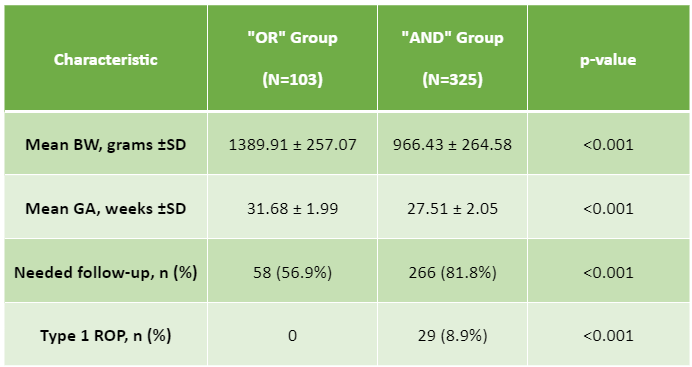Neonatology
Session: Neonatal General 8: ROP, Neurology
302 - Assessment of ROP Screening Criteria: the “OR” versus “AND” Study
Monday, May 6, 2024
9:30 AM - 11:30 AM ET
Poster Number: 302
Publication Number: 302.2888
Publication Number: 302.2888

Taylor Aaserud (she/her/hers)
Student
Cooper Medical School of Rowan University
Woodbury, New Jersey, United States
Presenting Author(s)
Background: The current US screening criteria for Retinopathy of Prematurity (ROP) include babies with gestational ages (GA) ≤ 30 weeks or birth weights (BW) ≤ 1500 grams. Although these guidelines are 100% sensitive for predicting Type 1 ROP, they potentially result in many unnecessary examinations when neonates do not meet both criteria. Indirect ophthalmoscopic exams are stressful for infants, require pediatric-trained ophthalmologists, and can only be performed in hospitals with a skilled physician available.
Objective: To evaluate the possible effects on ROP screening outcomes when following more stringent criteria of both GA and BW (“AND” group) compared to only using one criterion of GA or BW (“OR” group).
Design/Methods: A single-center retrospective chart review was performed at a tertiary academic medical center on infants who received ophthalmology consults while in the NICU between 2012 and 2022. Patients were divided into the more stringent “AND” group and compared to the broader “OR” group. Rates of Type 1 ROP and the need for subsequent inpatient follow-up after the initial evaluation were assessed among the “OR” versus the “AND” groups.
Results: Out of 576 infant ophthalmology consults reviewed, 428 met at least one of the criteria for ROP screening. Of those who qualified for screening, 103 “OR” neonates were compared to 325 “AND” neonates. Among the “OR” group, there was no development of Type 1 ROP, while 8.9% of the “AND” group progressed to Type 1 ROP and received treatment (p=0.002). Inpatient follow-up was necessary for 56.9% of the “OR” neonates and 81.8% of the “AND” neonates (p < 0.001). The “AND” group was overall lower in weight and more preterm (p < 0.001).
Conclusion(s): In this cohort, no patient meeting only one criterion for ROP screening (“OR” patients) progressed to Type 1 ROP, suggesting that excluding these patients from the ROP screening guidelines may not decrease sensitivity or lead to missed cases of disease. These findings support an amendment to the current US ROP screening guidelines to require only those who meet both criteria to receive a retinal examination in the NICU. This change in protocol will relieve some of the inpatient burden from excessive ROP screenings, decrease the demand for pediatric ophthalmologists, and eliminate an additional stressor on infirmed infants.

